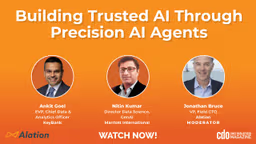AI News Bureau
Nobody Needs Dashboards, People Need Intelligence — Adobe CDO
Written by: CDO Magazine Bureau
Updated 12:00 PM UTC, Wed August 20, 2025
Adobe, a global leader in creativity and digital experiences, serves millions worldwide through flagship products such as Photoshop, Illustrator, Acrobat, and Adobe Experience Cloud. Adobe continues to innovate at the intersection of creativity, data, and AI — enabling enterprises and consumers to deliver personalized, data-driven experiences at scale.
In this second installment of a three-part interview, Bin Mu, Chief Data Officer and Vice President of Enterprise Data & Analytics at Adobe, speaks with Rohit Choudhary, CEO of Acceldata about redefining the semantic layer, rethinking the future of dashboards, and building a “data platform as a service” to deliver real-time, AI-driven intelligence directly to users.
The first part of this interview explored the evolution of Adobe’s data and AI strategies.
Edited Excerpts
Q: For those unfamiliar, what exactly were you aiming to capture in the semantic layer?
Different organizations may define the semantic layer differently or set different targets for it. At Adobe, for each entity — whether it’s a contract, a customer, or anything else — all of its attributes are consolidated. Think of it as a very wide and tall table or view, often with hundreds of attributes.
All attribute calculations are standardized based on business rules and policies, so when you pull one attribute, it’s consistent across the board. That’s the core idea of the semantic layer. Each business functional area or subject area has its own semantic layer that serves as its source of truth.
We are also working on cross-semantic linkages that connect these business areas together. This is a continuous process, with ongoing development and improvements.
Q: From your perspective, what will success look like for this next generation of AI-driven data capabilities at Adobe?
There’s never a final “end goal.” There are always periodic goals that we achieve step by step. As a business leader, when you need to make a decision, you’re not looking for a dashboard, you’re looking for intelligence. You want information that directly supports your decision-making.
What we are building at Adobe is a data-platform-as-a-service that enables any user, regardless of technical skill, to get the information they need.
If I’m a business user with no data engineering skills and no knowledge of which systems to access, I shouldn’t have to navigate dashboards or learn tools. I should be able to simply ask for the information in natural language and receive it instantly.
And it doesn’t stop there — based on the information retrieved, the platform should help facilitate decisions. This means you no longer have to reach out to different functional teams and wait months for responses. AI agents will deliver the information directly.
In short, nobody needs a dashboard. People need intelligence.
Q: Is there still a role for dashboards for returning users who need specific data, or are they becoming obsolete?
At a recent leadership offsite, I made three statements: first, workflow is dead; second, BI will increasingly shift to AI delivering insights; and third, traditional BI tools need to be replaced by AI-driven insight products.
For example, Adobe recently released the Adobe Experience Platform Agent Orchestrator. Imagine a CMO deciding it’s time for another campaign. Using a natural language interface, they can say: “Show me the campaign results for this product from this period of time.”
The system presents the results. The CMO then asks: “Help me understand the results.”
The platform responds with intelligence — identifying which segment outperformed others and suggesting levers to improve performance. The CMO can then say: “Design another campaign for this segment.”
The design, including the creative material, is produced instantly. From there, they can execute the campaign across email, social media, and other channels, and request real-time monitoring. The platform sets up the monitoring automatically.
All of this is orchestrated by AI agents without predefined workflows. Traditionally, this process would require multiple teams — marketing analytics to analyze performance, creative to design the campaign, IT to execute, and tech teams to build monitoring dashboards. Now, it happens seamlessly in a fraction of the time.
The reduction in friction, the cycle time savings, and the productivity impact are massive — even influencing how organizations think about their structure.
CDO Magazine appreciates Bin Mu for sharing his insights with our global community.






